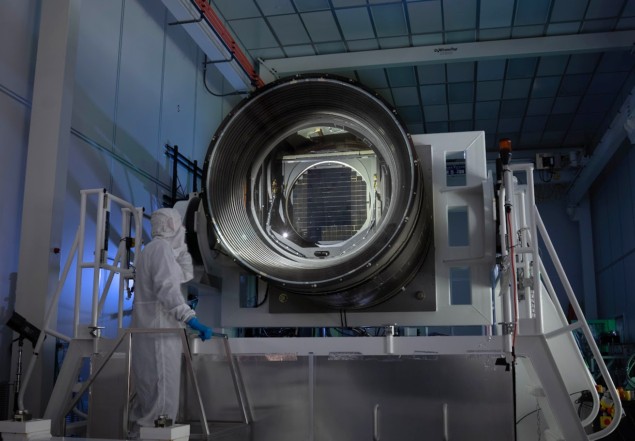Construction complete on the 3200-megapixel Legacy Survey of Space and Time camera
03 Apr 2024 Michael Banks
Eye on the sky: the Legacy Survey of Space and Time (LSST) camera will take a picture of the night sky over three or four nights (courtesy: Olivier Bonin/SLAC National Accelerator Laboratory)
Scientists and engineers have announced the completion of the Legacy Survey of Space and Time (LSST) – the largest camera ever built. Taking almost two decades to build, the 3200 megapixel instrument will form the heart of the 8.4 m Simonyi Survey Telescope based at the Vera C. Rubin Observatory in Cerro Pachón in the Andes.
First proposed some three decades ago to help study the nature of dark matter, the LSST has been built at the SLAC National Accelerator Laboratory. It is 3 × 1.65 m – roughly the size of a small car – and with a mass of 3000 kg.
The LSST includes three lenses, which have been constructed at the Lawrence Livermore National Laboratory. The biggest being 1.57 m in diameter and is the largest high-performance optical lens ever made. The LSST has now completed a programme of rigorous testing and will be shipped to Chile where it will be installed atop the Simonyi Survey Telescope later this year.
‘The greatest movie of all time’
The camera’s resolution of 3200 megapixel – some 200 times larger than a high-end consumer camera – means that it can take hundreds of ultrahigh-definition TVs to display just one of the LSST’s images at full size. The lenses for the Legacy Survey of Space and Time camera have been built at the Lawrence Livermore National Laboratory. (Courtesy: Jacqueline Ramseyer Orrell/SLAC National Accelerator Laboratory)
The lenses for the Legacy Survey of Space and Time camera have been built at the Lawrence Livermore National Laboratory. (Courtesy: Jacqueline Ramseyer Orrell/SLAC National Accelerator Laboratory)
 The lenses for the Legacy Survey of Space and Time camera have been built at the Lawrence Livermore National Laboratory. (Courtesy: Jacqueline Ramseyer Orrell/SLAC National Accelerator Laboratory)
The lenses for the Legacy Survey of Space and Time camera have been built at the Lawrence Livermore National Laboratory. (Courtesy: Jacqueline Ramseyer Orrell/SLAC National Accelerator Laboratory)“Its images are so detailed that it could resolve a golf ball from around 15 miles away, while covering a swath of the sky seven times wider than the full moon,” notes SLAC physicist Aaron Roodman, who is deputy director of the Vera C Rubin Observatory and leads construction of the LSST camera. “These images with billions of stars and galaxies will help unlock the secrets of the universe.”
Beginning next year, the LSST will spend over three or four nights to take a complete picture of the southern night sky. It will then replicate this process over a decade to produce almost 1000 full images of sky.
With the completion of the unique LSST camera we will soon start producing the greatest movie of all time and the most informative map of the night sky ever assembledŽeljko Ivezić
This will be used to observe the universe in unprecedented detail, plotting the positions and measuring the brightness of objects in the sky to help in improving our understanding of dark matter and dark energy, which is driving he expansion of the universe. It will examine 20 billion galaxies – some 10% of the galaxies predicted to exist in the observable universe.
The observatory will also be used to produce the most detailed star map of the Milky Way with the expectation to image 17 billion stars as well as catalogue some six million small objects within our solar system including asteroids.
“With the completion of the unique LSST camera we will soon start producing the greatest movie of all time and the most informative map of the night sky ever assembled,” notes astronomer Željko Ivezić from the University of Washington who is director of construction of the Vera C Rubin Observatory.

Michael Banks is news editor of Physics World magazine
from physicsworld.com 9/4/2024

Δεν υπάρχουν σχόλια:
Δημοσίευση σχολίου